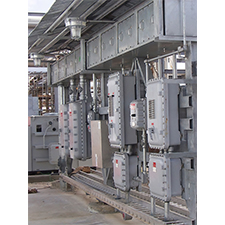
Switchrack: What Specifiers Need to Know
Chuck Ross
Designing industrial facilities is rarely a paint-by-numbers effort because each plant faces unique considerations, based on what it’s producing and the resulting safety and power requirements. That means power distribution equipment also needs to be custom designed. Electrical switchracks play important roles in these settings. These custom-engineered pieces of equipment produced to meet each customer’s unique needs, which can include power step-downs, motor starters and contactors, to name a few.
The term “switchrack” includes both the physical structure required to support attached electrical equipment and that equipment, itself. “Switchrack components will include motor controls, circuit breakers, transformers, panelboards, lighting, plugs and receptacles and other assorted switching and control equipment,” says Bogdan Moldovan, enclosure and controls product marketing manager with Emerson Automation Solutions. “What makes engineering a switchtrack special is that everything is customized, so no two switchracks are similar.”
On the surface, this description could sound a lot like switchgear, but there are some significant differences between the two equipment categories, primarily focused on electrical capacity. Switchgear is typically used to handle high-voltage power systems and can be rated for hundreds or even thousands of amps. Switchracks, on the other hand, are generally used for lower-voltage applications, and may be rated for tens or hundreds of amps.
Additionally, switchracks can be more exposed to the elements than switchgear because they don’t have the surrounding housing switchgear provides – they are literally busbar-equipped racks to which the specified electrical equipment is attached. As a result, specifiers need to clearly understand the hazards their switchracks could face, to ensure features like galvanizing are included for equipment that’s going to be installed in corrosive environments.
The term “switchrack” includes both the physical structure required to support attached electrical equipment and that equipment, itself. “Switchrack components will include motor controls, circuit breakers, transformers, panelboards, lighting, plugs and receptacles and other assorted switching and control equipment,” says Bogdan Moldovan, enclosure and controls product marketing manager with Emerson Automation Solutions. “What makes engineering a switchtrack special is that everything is customized, so no two switchracks are similar.”
On the surface, this description could sound a lot like switchgear, but there are some significant differences between the two equipment categories, primarily focused on electrical capacity. Switchgear is typically used to handle high-voltage power systems and can be rated for hundreds or even thousands of amps. Switchracks, on the other hand, are generally used for lower-voltage applications, and may be rated for tens or hundreds of amps.
Additionally, switchracks can be more exposed to the elements than switchgear because they don’t have the surrounding housing switchgear provides – they are literally busbar-equipped racks to which the specified electrical equipment is attached. As a result, specifiers need to clearly understand the hazards their switchracks could face, to ensure features like galvanizing are included for equipment that’s going to be installed in corrosive environments.
Photo courtesy of Appleton



